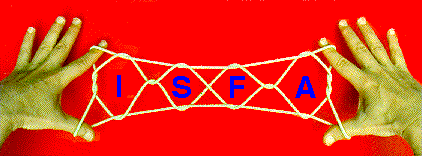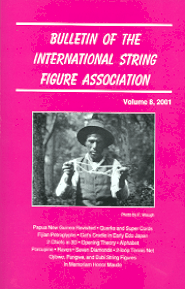Volume 8 (2001): 334 pages - Table des Matères
Edité par - Mark A. Sherman, Pasadena, California
Rédacteurs Associés - Joseph D'Antoni, Queens, New York; Myriam Namolaru, Haifa, Israel;
Belinda Holbrook, Davenport, Iowa; Stephan Claassen, Best, Netherlands.
Comité de Rédaction - Hiroshi Noguchi, Tokyo, Japan; Philip Noble, Inverness, Ecosse
Le Bulletin de l'Association Internationale du Jeu de Ficelle (BISFA) est une publication savante
présentant des documents originaux qui fait progresser notre compréhension et renforce
notre plaisir des jeux de ficelle. BISFA est publié annuellement, en septembre, par ISFA Press
(Pasadena, Californie). BISFA remplace le Bulletin de l'Association des Jeux de Ficelle,
(Toky Nippon Ayatori Kyokai), qui a été publiée en 19 volumes (1978-1993).
Les traductions proposées ne comprennent pas les illustrations et photos du texte original.
J'ai traduit ces textes pour vous donner un aperçu de la qualité et de la richesse de
ces publications.
Commentary
- Papouasie-Nouvelle-Guinée Revisitée: Un Récit autobiographique de récentes rencontres avec d'anciens amis aimant les jeux de ficelle, par Philip D. Noble, Prestwick, Ayrshire, Ecosse, (pages 1-15) - Au milieu des années 1970, le missionnaire Anglican Philip Noble a passé trois années dans les districts Musa et Managala de Papouasie-Nouvelle-Guinée où il a réussi à recueillir 140 figures et tours de ficelle. Son impressionnante collection a été publiée en1979 par the Institute of Papua New Guinea Studies à Boroko. L'an dernier (1-17 Décembre 2000) il est retourné en Papouasie-Nouvelle-Guinée pour la première fois depuis qu'il était venu en tant que missionnaire. Dans sa narration pittoresque, l'auteur décrit ses intéractions avec les anciens informateurs et fournit une mise à jour sur le statut des jeux de ficelle Papouasie-Nouvelle-Guinée au début du nouveau millénaire. Des instructions pour réaliser quatre nouveaux jeux de ficelle sont aussi fournies.
- Of String Figures, Quarks, and Super Cords by Sam Cannarozzi Yada, Parcieux, France, (pages 16-20) - String theory has been around since the 1960s, but did not gain wide acceptance until 1984 when a key mathematical problem was solved. Also known as "the theory of everything," string theory attempts to reconcile two conflicting disciplines: quantum mechanics, which describes the behavior of subatomic particles, and Einstein's theory of relativity, which deals with space, time, and gravity. Problems arise when physicists try to apply Einstein's theory to small distances (the realm of subatomic particles). String theory reconciles the two by postulating that photons, gluons, and other small building blocks of the universe are generated by one-dimensional strings that vibrate in all possible dimensions. In this article the author explores parallels between modern string theory and ancient games played with string.
Research Reports
- Cat's Cradle in the Literature of Early Edo Japan, by Yukio Shishido, Kyoto, Japan, (pages 21-38) - The earliest reference to cat's cradle in English literature dates from 1768, but in Japanese literature references appear as early as 1665. Additional references dating from the Early Edo period (1603-1750) suggest that cat's cradle was considered an elegant game for Japanese girls during this era. It remains popular to this day. In this article the author surveys various references to cat's cradle in poems, novels, and picture books of Early Edo Japan.
- Fijian and Polynesian String Figures Help Decipher Fijian Petroglyphs, by Sergei V. Rjabchikov, Krasnodar, Russia, (pages 39-45) - In this article I examine Fijian and Polynesian string figures and compare them to Polynesian art. The parallels allow me to draw attention to striking correspondences between mysterious Fijian petroglyphs and Easter Island (Rapa Nui) rongorongo glyphs. In addition, new evidence of trans-Pacific contact is offered.
- Jeux de ficelle et tours Ojibwés , recueillis par Frederick W. Waugh (1872-1924), édité et illustré par Mark Sherman, Pasadena, Californie, (pages 46-124) - La collection Ojibwée récemment découverte de Frederick Waugh nous offre notre premier coup d'oeil aux jeux et tours de ficelle, connus autrefois des Amérindiens vivant à l'est des Montagnes Rocheuses. La collection comprend 23 jeux de ficelle et 10 tours recueillis parmi les nord- Ojibwés de Lac Long, Ontario, et des Saulteaux de Lac Seul, il y a plus de quatre-vingt ans (1916-1920). C'est la première grand collection jamais publiée d'une tribu Algonquianophone. Comme beaucoup de répertoires du jeu de ficelle, le répertoire Ojibwé comprend une poignée de figures-coeur accompagnée par des variations. La majorité des figures est unique, mais clairement apparentée à des figures connues partout en Amérique du Nord, surtout celles du sud-ouest. Le répertoire comprend aussi quelques tours qui n'avaient jamais été recueillis auparavant, ce qui est étonnant, étant donné que la plupart des tours sont distribués globalement.
- Pangwe and Bubi String Figures, collected by Gnter Tessmann, translated by Axel Reichert, Bad Oldesloe, Germany, annotated and illustrated by Mark Sherman, Pasadena, California, (pages 125-201) - Between 1907 and 1909 German-born ethnographer Gnter Tessmann gathered thirty-nine string figures and one string trick from the Pangwe (Fang peoples) of modern day Cameroon, Equatorial Guinea, and Gabon. In 1915-16 he collected four figures and three tricks from the Bubi of Fernando Poo (now called Boiko Island). In 1912 his Pangwe collection was published in the journal Baessler Archiv. His Bubi collection appeared in a book published in 1923. Unfortunately, both collections have remained inaccessible to most string figure enthusiasts because the instructions are written in German and illustrations are lacking for the majority of figures. In this article, the authors offer an English translation. Illustrations and supplemental notes are also provided.
- Deux Chefs en 3-D: Vers une théorie générale des jeux de ficelle en trois dimensions , par Frank J. Oteri, New York, New York, (pages 202-210) - Dans son livre classique Caroline Furness Jayne a publié les instructions pour réaliser un jeu de ficelle micronésien en deux dimensions nommé 'Deux Chefs.' Dans cet article, l'auteur présente une méthode simplifiée qui commence avec un métier à tisser à deux boucles. Puis il explique comment itérer une portion de la séquence tissée pour donner n'importe quel nombre de Chefs, et montre comment un analogue en trois dimensions de cette figure peut être réalisé en modifiant le métier à tisser original. L'auteur suggère que son approche globale pourrait s'avérer utile dans la réalisation d'itérations, des analogues 3-D d'autres jeux de ficelle simples qui commencent avec un métier à tisser à deux boucles.
- Usage de Jeux de Ficelle pour l'Enseignement de l'adresse Mathématique — Partie 5: Théorie du Berceau , par James R. Murphy (inoli), New York, New York, (pages 211-234) - Les jeux de ficelle sont d'excellents outils pour aider les étudiants à acquérir l'adresse spatiale. Ils encouragent aussi la pensé analytique, lorsqu'ils sont enseignés de façon systématique. Dans cet article l'auteur présente encore un autre article, qu'il emploie pour enseigner l'adresse mathématique aux étudiants, qui ne réagissent pas aux méthodes traditionnelles d'apprentissage. Deux concepts spatiaux, la chiralité et l'asymétrie, sont explorés à travers la variation systématique d'une figure simple.
Modern String Figures
- Un Alphabet en Jeux de Ficelle , par Carey C.K. Smith, Stratford, Nouvelle Zélande, (pages 235-255) - La plupart des jeux de ficelle traditionnels ont été créés par des gens qui n'avaient pas de langage écrit. Pourtant, certains de leurs motifs ressemblent aux lettres de l'alphabet. Dans cet article; l'auteur combine ces figures avec quelques unes des siennes pour former un alphabet complet alphabet.
- Porcupine String Figures, by Kazuo Kamiya, Saitama, Japan, (pages 256-273) - 'Porcupine' is a traditional North American string figure known to Indians and Inuit alike. In this article the author introduces a new method for making 'Porcupine' plus eight variations. The variations represent various animals, including a dog, a cat, and a caribou. Methods for making double versions of each are also given. All the figures in this article are described using a new shorthand notational system devised by the author.
- Raven String Figures, by Kazuo Kamiya, Saitama, Japan, (pages 274-284) - 'Raven' is an Inuit string figure known throughout the Arctic regions of Alaska, Canada, and Greenland. In this article the author introduces two new methods for making 'Raven' plus thirteen novel variations. The variations represent various animals (dog, pony, flying crane, dove, and swan) plus various numbers (1, 2, 4, 6, and 9).
- Seven Diamond String Figures, by Kazuo Kamiya, Saitama, Japan, (pages 285-315) - 'Seven Diamonds' is a classic net figure that is easy to make. In this article the author examines the many ways in which 'Seven Diamonds' can be made. He then shows how variation leads to nets with five, thirteen, fourteen, twenty-one, and twenty-five diamonds. A method for doubling the frame string is also given.
- Tennis Net with Two Loops, by Tetsuo Sato, Kumamoto, Japan, (pages 316-320) - The use of two loops when making string figures greatly increases the number of possible manipulations. The resulting designs are potentially more intricate and beautiful, especially when loops of different colors are used. In this article the author presents a two-loop version of Murphy's '4-loop Tennis Net', an elaborate mesh that appeared in last year's Bulletin.
Obituary
- In Memoriam Honor Maude (1905-2001), par Alaric Maude, Adelaide, Australie, (pages 321-324).
Book Review - by Mark Sherman (pages 325-326)
- Ficelles, by Daniel Picon.
Letters to the Editor (pages 327-334)
- Le Drapeau Impossible rendu Possible - Ron C. Read. Dans le Bulletin de l'année dernière, Tetsuo Sato nous a présenté 'Le Drapeau Olympique', descrit comme "un jeu de ficelle impossible ." Sa méthode de construction ingénieusenécessite le découpage et le nouage de la ficelle. Mais si nous renonçons à ce que les ficelles du cadrs soient transverses, le drapeau impossible est vraiment possible! L'auteur donne la méthode de construction.
- A Helping Hand - Philip D. Noble. The author describes a heart-warming encounter he had with a Norwegian submarine officer who had lost an arm many years ago. Together they were able to do a string trick the officer learned while serving in the Navy. The author provides illustrated instructions.
- Mongolia: Land of 15,000 Strings - David Titus. The author describes a recent trip to Mongolia where he distributed thousands of colorful string loops and learned a few Mongolian string figures and tricks, all of which have been seen elsewhere.
- Etoile Express - Bob Grimes. L'autheur donne les instructions pour réaliser une simple étoile qui demande seulement une "moitié de seconde" pour etre formée.
- Ladder Patter - Mary Beth Andersen. Verbal cues are helpful when teaching children how to make string figures. The author presents her "patter" for teaching 'Jacob's Ladder' to kids.
- Sensation: Russian Pupils Played String Games in 1970s - Sergei V. Rjabchikov. The Cat's Cradle series was indeed known in Russia. The author provides names and illustrations of some of the designs shown to him by several women.
Ajouter un commentaire



